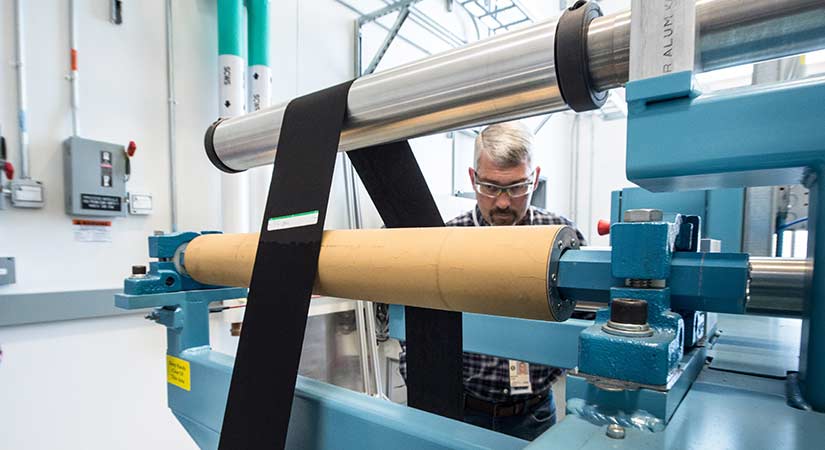Energy Conservation with Rolling
Energy Conservation in Rolling Motion
$$mgh = \frac{1}{2}mv^2 + \frac{1}{2}I\omega^2$$Initial gravitational potential energy equals final translational plus rotational kinetic energy.
When an object rolls down an incline or up a ramp, energy is conserved (in the absence of friction). The gravitational potential energy is converted into both translational and rotational kinetic energy. The distribution between these two forms depends on the object's shape and moment of inertia.
Energy Distribution in Rolling
The total kinetic energy of a rolling object is split between:
- Translational Kinetic Energy: $K_{\text{trans}} = \frac{1}{2}mv^2$
- Rotational Kinetic Energy: $K_{\text{rot}} = \frac{1}{2}I\omega^2$
Using the rolling condition $v = \omega R$ and $I = kmR^2$, we can express the total kinetic energy as:
Interactive Simulation: Rolling Up a Ramp
Explore how energy is distributed between translational and rotational motion as an object rolls up a ramp.
Initial Kinetic Energy: 375.0 J
Current Height: 0.0 m
Current Velocity: 10.0 m/s
Angular Velocity: 10.0 rad/s
Energy Distribution:
Energy Conservation Examples
Example 1: Rolling Down an Incline
A solid sphere of mass $2\,\text{kg}$ and radius $0.1\,\text{m}$ starts from rest at a height of $3\,\text{m}$ and rolls down a frictionless incline. What is its speed at the bottom?
Solution:
Initial energy: $E_i = mgh = 2 \times 9.8 \times 3 = 58.8\,\text{J}$
Final energy: $E_f = \frac{1}{2}mv^2(1 + k)$ where $k = 0.4$ for a solid sphere
Energy conservation: $58.8 = \frac{1}{2} \times 2 \times v^2 \times 1.4$
$v = \sqrt{\frac{58.8}{1.4}} = 6.48\,\text{m/s}$
Example 2: Rolling Up a Ramp
A hollow cylinder with initial speed $8\,\text{m/s}$ rolls up a $30°$ incline. How high does it go before stopping?
Solution:
Initial kinetic energy: $K_i = \frac{1}{2}mv^2(1 + k)$ where $k = 1.0$ for hollow cylinder
$K_i = \frac{1}{2}m(8^2)(2) = 64m\,\text{J}$
Final potential energy: $U_f = mgh$
Energy conservation: $64m = mgh$
$h = \frac{64}{9.8} = 6.53\,\text{m}$
Example 3: Comparing Different Shapes
Three objects with the same mass and radius roll down the same incline: a solid sphere, solid cylinder, and hollow cylinder. Which reaches the bottom first?
Solution:
Solid sphere: $k = 0.4$, energy factor = 1.4
Solid cylinder: $k = 0.5$, energy factor = 1.5
Hollow cylinder: $k = 1.0$, energy factor = 2.0
Answer: The solid sphere reaches the bottom first because it has the lowest moment of inertia and thus the most translational kinetic energy.
Effect of Friction
Friction plays a crucial role in rolling motion. When there is enough friction, an object can roll without slipping. In this case, friction allows some of the object's energy to be converted into rotational kinetic energy as it moves. This rotational energy can then be transformed back into translational kinetic energy, helping the object reach higher points on an incline or ramp than it would if it were simply sliding without friction.
- Rolling Without Slipping: Friction enables the object to roll, allowing energy to transfer between translation and rotation. This can help the object reach higher heights, as rotational energy can be converted back to translational energy as it climbs.
- No Friction (Sliding): If there is no friction, the object slides without rotating. All the energy remains as translational kinetic energy, and the object cannot convert rotational energy back to help it climb higher.
- Energy Dissipation: If friction is too high (kinetic friction or energy loss), some energy is converted to heat, and the object will reach a lower height.
Energy Distribution by Shape
| Shape | k Value | Energy Factor (1+k) | % Translational | % Rotational |
|---|---|---|---|---|
| Solid Sphere | 0.4 | 1.4 | 71.4% | 28.6% |
| Solid Cylinder | 0.5 | 1.5 | 66.7% | 33.3% |
| Hollow Cylinder | 1.0 | 2.0 | 50.0% | 50.0% |
| Thin Ring | 1.0 | 2.0 | 50.0% | 50.0% |
Real-World Applications
- Automotive Engineering: Understanding energy distribution in vehicle dynamics
- Sports Equipment: Ball design affects rolling behavior and energy efficiency
- Industrial Machinery: Optimizing rolling systems for energy efficiency
- Transportation: Wheel design affects fuel efficiency and performance
- Physics Experiments: Studying energy conservation in rolling systems

Advanced Concepts
Energy Loss Mechanisms
Even in "frictionless" rolling, there are energy losses:
- Air Resistance: Affects high-speed rolling objects
- Deformation: Object and surface deform slightly
- Internal Friction: Within the rolling object
- Sound: Energy converted to acoustic waves
Non-Conservative Forces
When friction is present, mechanical energy is not conserved:
Summary / Takeaways
- Energy conservation in rolling: $mgh = \frac{1}{2}mv^2 + \frac{1}{2}I\omega^2$
- Total kinetic energy: $K_{\text{total}} = \frac{1}{2}mv^2(1 + k)$
- Shape affects energy distribution between translation and rotation
- Objects with lower moment of inertia (smaller k) roll faster
- Friction reduces the maximum height an object can reach
- Understanding energy distribution is crucial for engineering applications